Exam #3 Basic Audiology
0.0(0)
0.0(0)
Card Sorting
1/134
Earn XP
Description and Tags
Study Analytics
Name | Mastery | Learn | Test | Matching | Spaced |
|---|
No study sessions yet.
135 Terms
1
New cards
Two response modes used in measuring SRT in young children are _____ and _____.
Picture-pointing, Body-part identification
2
New cards
According to the ASHA method, speech recognition threshold is found by using:
bracketing technique
3
New cards
All of the following statements are true except:
The SDT is usually found at a 20 dB higher level of intensity than the SRT
4
New cards
The predicted SRT (Speech Reception Threshold) for the left ear is ____ dB HL
25 dB HL
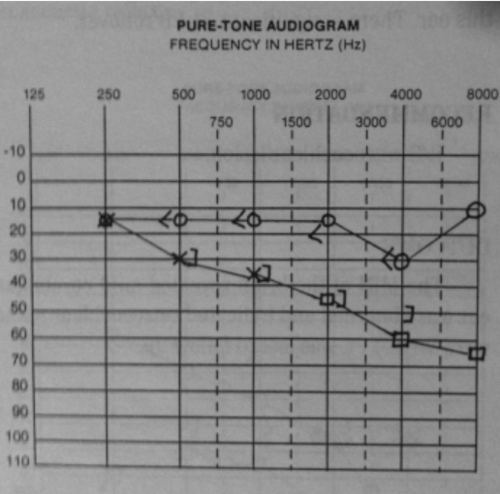
5
New cards
LDL stands for Listener Detection Level.
false
6
New cards
When speaking into a microphone during speech testing, if you set the output to 60 and the VU meter reads +5, what level are you actually presenting the sound to the patient?
65
7
New cards
All of the following are advantages of using pre-recorded materials in speech testing, EXCEPT:
Allows for the most flexibility and saves time
8
New cards
When working with the adult population, the most common response mode during clinical speech audiometry is verbal
true
9
New cards
Spondee words are:
two-syllable words with equal stress on each syllable
10
New cards
It is logical that tests of hearing function be performed with speech as the stimuli because:
hearing and understanding speech is the greatest complaint of hearing impaired people
11
New cards
_____ is helpful when working with infants, uncooperative children, or persons with reduced cognitive function.
SDT
12
New cards
When working with the adult population, the most common response mode during clinical speech audiometry is verbal.
True
13
New cards
Speech detection threshold:
and speech awareness threshold refer to the same speech test.
14
New cards
Hudgins determined four criteria that should be used when selecting words for SRT testing. Which of the following is NOT one of the criteria determined by Hudgins?
For simplicity, words should only be one syllable
15
New cards
During speech testing, it is important for the client to be facing the clinician.
False
16
New cards
Which of the following is an advantage of using spoken response during speech testing?
It's faster
17
New cards
____ is defined as the intensity level that a person perceives as comfortable to listen to
MCL
18
New cards
The _____ is defined as the lowest intensity level in dB HL at which a person can correctly identify about 50% of the speech material presented.
SRT
19
New cards
Which of the following is NOT an example of a spondee word?
Group of answer choices
Group of answer choices
Microwave
20
New cards
Speech Detection Threshold
and speech awareness threshold refer to the same speech test
21
New cards
The PTA and SRT should be within:
+ or - 6 dB of each other
22
New cards
Concerning SDT which of the following is NOT true?
The patient must repeat the word perfectly
23
New cards
________ is defined as the intensity level that a person perceives as comfortable to listen to.
MCL
24
New cards
Which type of "two Stressed syllable" words are used most commonly in SRT testing?
Spondaic
25
New cards
Hearing losses do not necessarily extend the LDL
True
26
New cards
Which of the following is not a purpose for finding the MCL:
to determine the level of audibility
27
New cards
Phonetically balanced means that the percent of time any given sound appears on the word list is equal to its occurrence in the English language
True
28
New cards
Which loudness level helps to define the dynamic range of a patient?
LDL
29
New cards
Word recognition is more accurate with a fifty-word list than with a twenty-five-word list.
True
30
New cards
____________ is an informative but non-emotional series of sentences, recorded at a constant level, used to help determine MCL.
Cold running speech
31
New cards
Using the audiogram below, a predicted Word Recognition Score for the right ear is ____ percent
92

32
New cards
A predicted LDL for the right ear is ____ dB HL
110
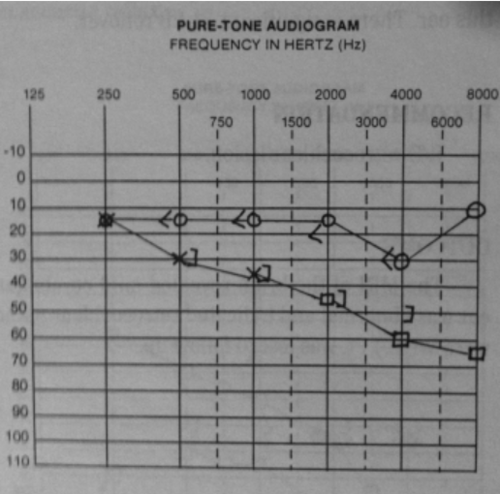
33
New cards
Optimal word recognition scores are found at an intensity level ____ to ____ dB higher than their MCL.
5, 10
34
New cards
In word recognition testing, the phrase "at the word..." is known as ___
Carrier
35
New cards
The purpose of word recognition testing is to:
All of the answers listed
36
New cards
Most normal-hearing person will report speech MCl's that are 70-80 dBHL higher than audiogram threshold.
False
37
New cards
The LDL for most individuals with normal hearing is about:
100 to 110 dB
38
New cards
When a patient has a very poor WRS score that is inconsistent with the hearing loss present, it may be a sign of possible ___
Retrocochlear disorder
39
New cards
Optimal word recognition scores are found at an intensity level _______ to _____ dB higher than their MCL.
5, 10
40
New cards
When performing word recognition testing, the standard is to begin testing at _____ dB above the patient's SRT
40
41
New cards
In a diminishing WRS score, the point where the soces begin to decrease is known as the rollover effect.
True
42
New cards
We can expect WRS to be reduced in direct proportion to the degree of hearing loss in __________ hearing loss.
Sensorineural
43
New cards
The maximum score in word recognition performance is always at a comfortable listening level
False
44
New cards
_____________ is an informative but non-emotional series of sentences, recorded at a constant level, used to help determine MCL
Cold running speech
45
New cards
In a diminishing WRS score, the point where the scores begin to decrease is known as the rollover effect
True
46
New cards
The best word-recognition score obtainable regardless of intensity is known as the:
PB max
47
New cards
When a patient has a very poor WRS score that is inconsistent with the hearing loss present, it may be a sign of a possible _______.
Retrocochlear disorder
48
New cards
he ____ sounds are typically found in the mid to high frequencies (above 1000 Hz) while ____ are found in the lower frequencies (below 1000 Hz).
Consonants, vowels
49
New cards
_______ is described as the intensity level that a person perceives as comfortable to listen to.
MCL
50
New cards
A patient's LDL is also known as all of the following, EXCEPT:
Most uncomfortable signal (MUS)
51
New cards
A patient with a word recognition score of 84-90% would have ___ word recognition ability:
Very good
52
New cards
If a patient has an SRT of 65 dB, a WRS of93% and an LDL of 95 dB, what is their dynamic range?
30 dB
53
New cards
Uncomfortably loud, loud, comfortable, comfortable but soft, and very soft are all categories a patient may use to describe the level of the stimulus when a clinician is trying to find their _______.
LDL
54
New cards
A word recognition score of 72% would have _____ word recognition ability.
Fair
55
New cards
There's a distinction between a threshold for speech and ability to understand the speech that is heard
True
56
New cards
MCL stands for:
Most Comfortable Level
57
New cards
A predicted WRS for the right ear is ____ percent:
92
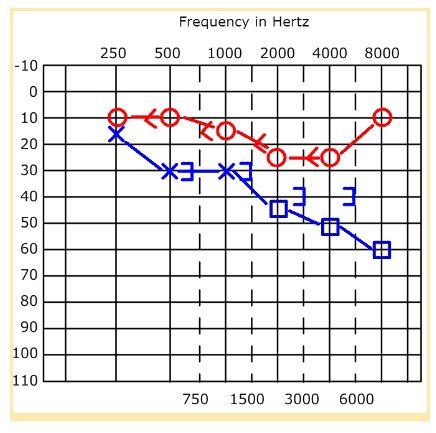
58
New cards
THE Following QUESTION PERTAINS TO AUDIOGRAM FOUR. The right ear would most accurately be described as a _________ configuration.
flat
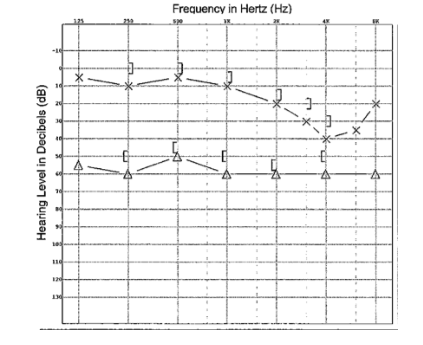
59
New cards
According to the given audiogram, what type of hearing loss is present?
Conductive
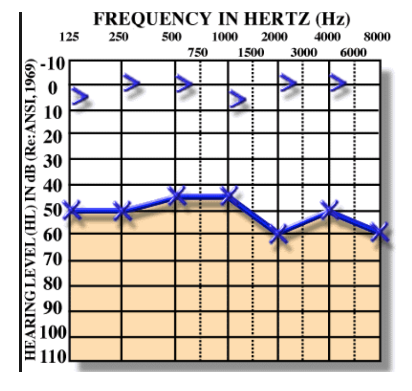
60
New cards
When interpreting an audiogram, you should scan the audiogram form immediately for information on:
All of the listed answers are correct
61
New cards
Other hearing test findings may be abnormal, even for patients with normal audiograms
True
62
New cards
Masking was used during testing for:
both air conduction and bone conduction testing
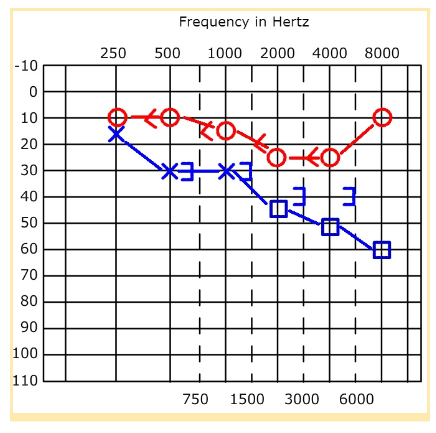
63
New cards
THE FOLLOWING QUESTION PERTAINS TO AUDIOGRAM THREE. Assuming the use of supra-aural earphones, which air-conduction thresholds need to be retested in the right ear (TE) with masking in the left ear (NTE)?
500 through 2000 Hz
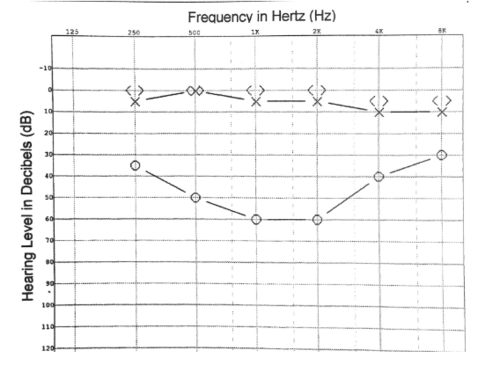
64
New cards
THE FOLLOWING QUESTION PERTAINS TO AUDIOGRAM FOUR. A predicted SR or the left ear would be_______ dB HL
15
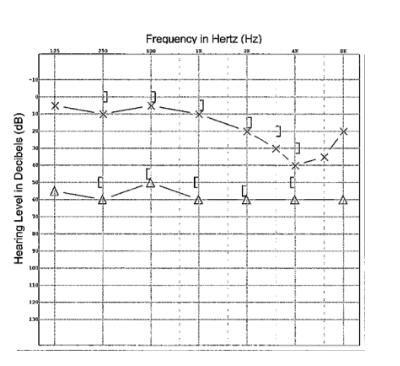
65
New cards
If a patient presented with the following results, what would be their dynamic range?
SRT: 35 dB HL
PTA: 30 dB HL
WR: 92%
LDL: 105 dB HL
MCL: 75 dB HL
SRT: 35 dB HL
PTA: 30 dB HL
WR: 92%
LDL: 105 dB HL
MCL: 75 dB HL
70 dB HL
66
New cards
Audiogram interpretation:
All of the listed answers are correct
67
New cards
A predicted LDL for the right ear is ____ dB HL
100-110
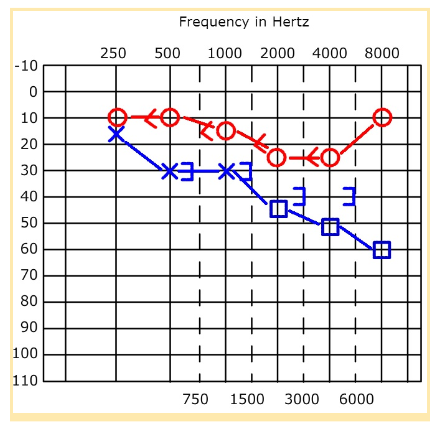
68
New cards
When analyzing audiogram findings, which of the following statements is true?
All of the above
69
New cards
Accurate audiogram interpretation does not require practice or clinical expertise
False
70
New cards
Is it possible, after masking, that this client could have a unilateral sensorineural hearing loss?
Yes
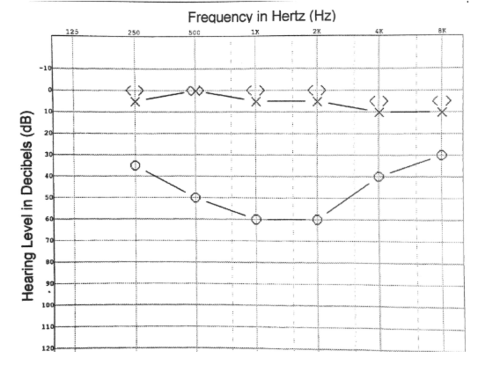
71
New cards
Does any more masking need to be completed in this patient?
No
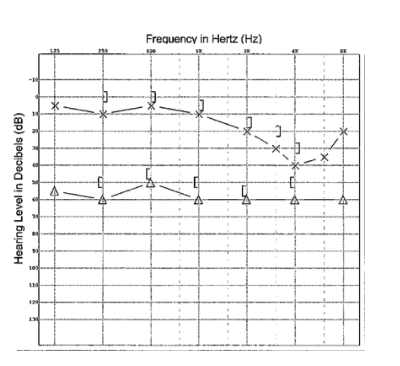
72
New cards
THE FOLLOWING QUESTION PERTAINS TO AUDIOGRAM ONE. If the patient is tested using supra aural headphones, is it necessary to mask by air conduction?
No
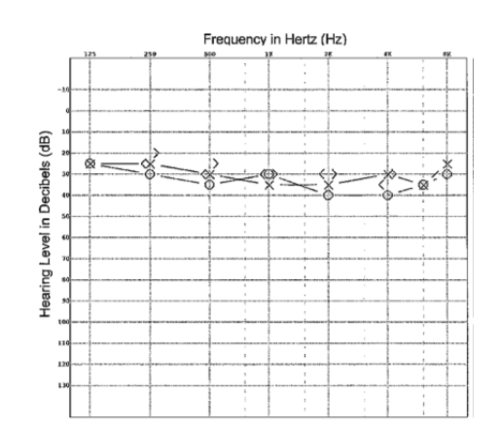
73
New cards
Audiogram interpretation focuses on how test findings are related to possible causes of hearing loss or the patient's underlying auditory dysfunction.
True
74
New cards
A predicted SRT score for the left ear on the audiogram below would be between _________ and _________ dB HL.
35-45 or 34-46
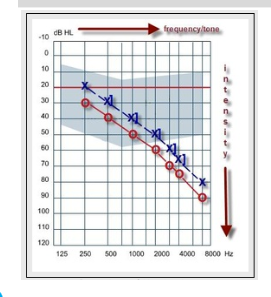
75
New cards
THE FOLLOWING QUESTION PERTAINS TO AUDIOGRAM FOUR. Has masking been used to test air conduction (AC) and bone conduction (BC) on this patient?
Yes, AC and BC
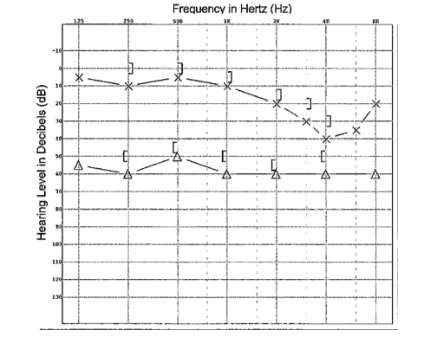
76
New cards
THE Following QUESTION PERTAINS TO AUDIOGRAM FOUR. The right ear would most accurately be described as a _________ configuration
Flat
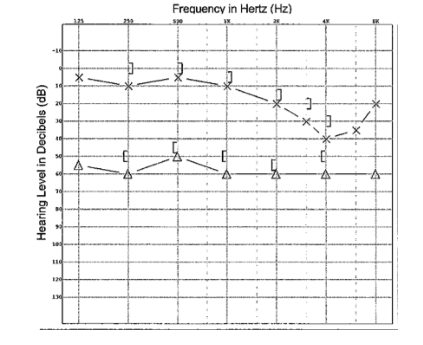
77
New cards
What type of hearing loss does this patient have?
Moderate sensorineural in right ear and mild sensorineural in left ear
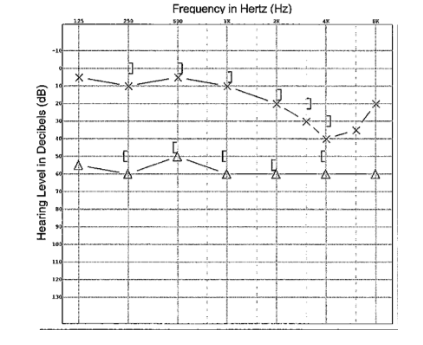
78
New cards
Audiogram interpretation
All of the listed answers are correct
79
New cards
Using the Audiogram below, the left ear PTA is _____dB. The right ear PTA is _______ dB.
40, 50
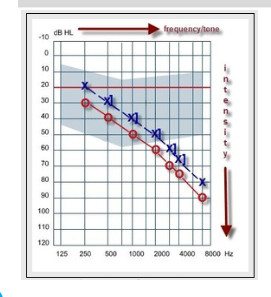
80
New cards
The predicted SRT for the left ear is ____ dB HL
35 dB HL
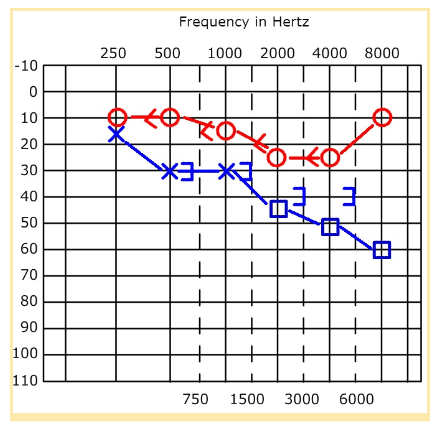
81
New cards
According to the given audiogram, what type of hearing loss is present?
mixed
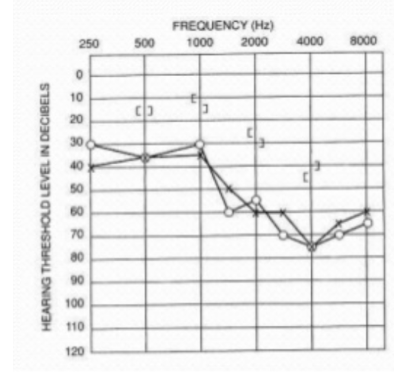
82
New cards
Speech Detection Threshold (SDT) aka Speech Awareness Threshold (SAT)
is the lowest intensity level in dB HL at which a person is aware of or can detect the presence of speech signals.
83
New cards
SDT stands for
Speech Detection Threshold
84
New cards
SAT stands for
Speech Awareness Threshold commonly used synonym for SDT
85
New cards
SRT stands for
Speech Recognition Testing
86
New cards
SRT
speech recognition threshold, measured using spondees. It is the intensity level at which the patient correctly repeats between 50-70% of the spondee words.
87
New cards
WRS stands for
word recognition score
88
New cards
WRS
to determine the extent of the speech-recognition difficulty.
Aid in diagnosis of the site of the disorder in the auditory system.
Assist in the determination of the need for and proper selection of hearing instruments
To help the clinician make a prognosis for the outcome of treatment efforts
Phonetically balanced word lists
50 word list recommended
Aid in diagnosis of the site of the disorder in the auditory system.
Assist in the determination of the need for and proper selection of hearing instruments
To help the clinician make a prognosis for the outcome of treatment efforts
Phonetically balanced word lists
50 word list recommended
89
New cards
LDL stands for
loudness discomfort level
90
New cards
LDL
defines the intensity level at which sound becomes uncomfortable or causes discomfort.
91
New cards
MCL
most comfortable level
92
New cards
How to predict SRT based off of the audiometric results
based on the PTA +/- 5 of the PTA
93
New cards
How to predict LDL based off of the audiometric results
predicted at 110 dB, regardless of their hearing loss
94
New cards
How to predict WRS based off of the audiometric results
will change depending on the type of hearing loss (SNHL vs conductive)
95
New cards
For Normal Hearing
SRT is....
WRS is .....
MCL is ......
LDL is.......
SRT is....
WRS is .....
MCL is ......
LDL is.......
SRT = PTA =/- 5dB
WRS = 90% or greater
MCL= 40-55 dB above threshold (SL)
LDL= 100 to 110 dB HL
WRS = 90% or greater
MCL= 40-55 dB above threshold (SL)
LDL= 100 to 110 dB HL
96
New cards
For Conductive Hearing Loss
SRT is....
WRS is .....
MCL is ......
LDL is.......
SRT is....
WRS is .....
MCL is ......
LDL is.......
SRT = PTA =/- 5 dB
WRS 90% or greater
MCL 40 to 55 dB above threshold (SL)
LDL= unreachable
WRS 90% or greater
MCL 40 to 55 dB above threshold (SL)
LDL= unreachable
97
New cards
For Sensorineural Hearing Loss
SRT is....
WRS is .....
MCL is ......
LDL is.......
SRT is....
WRS is .....
MCL is ......
LDL is.......
SRT = PTA =/- 5dB
WRS= reduced in direct proportion to degree of hearing loss
MCL- reduced
LDL= 80 to 110 dB HL
WRS= reduced in direct proportion to degree of hearing loss
MCL- reduced
LDL= 80 to 110 dB HL
98
New cards
Understand MLV and the use of a VU meter.
MLV- monitored live voice
VU meter - volume unit meter
Indicates to us the volume or intensity of the input prior to the time it reaches the attenuator
VU meter - volume unit meter
Indicates to us the volume or intensity of the input prior to the time it reaches the attenuator
99
New cards
Define PB max
-PI function is also known as performance intensity function and the PB max.
-Word recognition testing is repeated after increasing the presentation level to a higher intensity level.
-Word recognition testing is repeated after increasing the presentation level to a higher intensity level.
100
New cards
Know the predicted LDL levels for individuals.